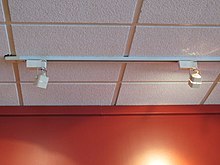Track lighting
This articleneeds additional citations forverification.(April 2012) |

Track lightingis a method oflightingwherelight fixturesare attached anywhere on a continuous track device which containselectrical conductors.[1][2]This is in contrast to directly routing electrical wiring to individual light positions. Tracks can either be mounted to ceilings or walls, lengthwise downbeams,or acrossraftersorjoists.They can also be hung with rods from especially high places likevaulted ceilings.
Track lighting was invented by Anthony Donato ofLightolier.Donato received the first patent related to track lighting in 1961.[3]
Tracks
[edit]There are multiple types of tracks used worldwide, for example:
Typical systems haveline voltagerunning through a recessed track. The track may have more than one live conductor, so that multiple switched circuits can be used to control different fittings on the same track. Installers will place the tab of the connector on the fixture to one side or the other when attaching it to the track.
Many systems now use a single live wire and then use digital control interfaces such asDALIto control the fittings. This means that each fitting can be independently controlled even with a single live conductor.
Lamps
[edit]Track lighting is usually combined with directional lamps with reflectors, such as spotlights.[1]These lamps can run under either mains voltage or a lower (often 12 V) voltage.
It is common to see line-voltage tracks with low-voltage fixtures. For these, each fixture requires a small built-intransformerto operate it. Alternatively, more modern systems are available withlow voltage(10, 12, or 24 volts) running through the track, which is in itself decorative. In this case, the fixture may clamp onto a track made of two metal strips separated with aninsulatingstrip. Two-circuit configurations are rare in such systems. The track is powered by a transformer which converts the high voltage into low voltage. There are magnetic and electronic transformers.
For all low-voltage fixtures or systems a specialdimmer(if used) is required, as standard dimmers cause flickering because of the interaction with the transformers' load characteristics: magnetic transformers are inductive, while electronic ones are capacitive. The dimmers control the mains input to the transformers.[4]
Variations
[edit]Cable lightingis a variation where the fixtures are hung from uninsulated cables which carry low voltage. These fixtures range from the very simple, such as two hinged rods from which ahalogen lamphangs, to the very artful, such as a humansilhouettewhose feet touch the wires and hands hold the bulb or itssocket.Two sets of cables (such as in the corner of a room where two walls meet) can be connected together with short wires that have clips (such asalligator clipsorscrewclamps) at either end.
Another variation is calledflex trackormonorail tracklighting in which the fixtures are hung from a single line monorail track attached to the ceiling using stems. There are several different types of track. Some are very flexible and can be curved in any shape or form and some are more rigid and can be curved very slightly. Some patterns that can be made are "S curves" or "spirals". Various adapters are available for combining features of track and other lighting. There are "L" and "T" adapters for rigid track, as well as flexible ones for unusual angles, or to change the vertical angle where a ceiling changes slope. Adapter plates allow single fixtures to be attached directly to a junction box, by providing an extremely small section of track embedded into the plate. There are also arms which have the same feature, allowing fixtures to be mounted onto the same wall they shine onto, and having an attachedpower cordand wall plug.
If the track is properly anchored, a hanging fixture may be suspended from it. The track itself can also be suspended. Rather than being hard-wired to ajunction box(which requires a feeder device to be snapped into the track, either in the middle or at one end), it can also be end-fed from a standard wall outlet. Outlets can also be snapped into line-voltage track.
Gallery
[edit]-
An H-track fixture head with integrated transformer, showing 2 of the 3 contacts on the same side. Model No. Hampton Bay EC762.
-
Two H-track fixtures for mains-voltage light bulbs, by Hampton Bay. Model No. EC719 (white, E26/[PA]R20) ES0208SBA (brown, GU10/MR16).
-
EPL Minimax O LED track fixture, with cross-baffle visible.
References
[edit]- ^abPopular Science.Bonnier Corporation.
- ^National Fire Protection Association (2017). "Article 100 Definitions".NFPA 70 National Electrical Code.1 Batterymarch Park, Quincy, Massachusetts 02169: NFPA.RetrievedOctober 9,2023.
Lighting track (track lighting): a manufactured assembly designed to support and energize luminaires that are capable of being readily repositioned on the track. Its length can be altered by the addition or subtraction of sections of track.
{{cite book}}:CS1 maint: location (link) - ^"The History and Function of Track Lighting".Insights by Alcon Lighting.February 24, 2020. Archived fromthe originalon August 7, 2020.RetrievedOctober 27,2022.
- ^"Lutron Guide To Dimming Low Voltage Lighting | Lighting Services Inc".Lighting Services Inc.(Also available as aPDFfrom lutron.com)


![Two H-track fixtures for mains-voltage light bulbs, by Hampton Bay. Model No. EC719 (white, E26/[PA]R20) ES0208SBA (brown, GU10/MR16).](https://upload.wikimedia.org/wikipedia/commons/thumb/4/47/HamptonBay_H-type_120V_fixture_EC719_ES0208SBA.jpg/90px-HamptonBay_H-type_120V_fixture_EC719_ES0208SBA.jpg)
